Northumberland
EARLY CHURCH HISTORY
To set the scene in these remote parts, a brief outline of events in the seventh century may be useful. Those who find historical details confusing might wish to skip this section!
In 625, King Edwin of Northumbria (585-633) married Ethelburga, daughter of King Ethelbert of Kent. In 597, Ethelbert and his Christian wife Bertha had played host to St Augustine and his group of monks sent from Rome by Pope Gregory. After some hesitation the king embraced the new teaching and accepted baptism, and his capital at Canterbury became the centre of the new church.

Lindisfarne Castle
As part of her marriage contract, Ethelburga insisted on being allowed to practise her faith, and when she travelled north to marry Edwin, she was accompanied by Paulinus as her chaplain. Paulinus used this opportunity to preach the Christian message to Edwin and his courtiers and after much deliberation, he and many of his relatives and nobles were baptised at York on Easter Day 627. York thus became the second great focus of Christian witness in England.
With Edwin's support, Paulinus travelled around Northumbria preaching and baptising and for a few years the church made rapid progress. All this came to an abrupt halt when Edwin was defeated and killed at the Battle of Hatfield Chase on 12th October 633 by the heathen King Penda of Mercia, assisted by the Welsh king Cadwallon. Paulinus gathered up Ethelburga and her children and fled back to Kent by sea.
Oswald (c604-642) was the nephew of Edwin, but in the course of dynastic rivalries, his father had been killed in 617, and Oswald fled north, spending some time in exile on Iona in Scotland. Here he accepted Christianity in its Celtic form. When Edwin was killed, Oswald returned to claim Northumbria and defeated Cadwallon at the Battle of Heavenfield, near Hadrian's Wall, in 635.

St Aidan
Resolving to extend Christianity in his kingdom, Oswald sent to Iona for a priest. Several candidates were reluctant to undertake so hopeless a task, but eventually the zealous and saintly Aidan was consecrated bishop in 635. He set up his headquarters on Lindisfarne and there followed seven fruitful years of cooperation, as they travelled together to evangelise the kingdom, Oswald acting as Aidan's interpreter. Churches were built in many parts of Northumbria. Oswald's influence extended well beyond his own domain. When King Cynegils of Wessex accepted the new faith, Oswald stood sponsor as he was baptised by Birinus at Dorchester, near Oxford, and married Cynegils' daughter Kyneburga. The happy partnership with Aidan ended when Oswald was killed at the Battle of Maserfield in 642 by the same King Penda who had defeated Edwin in 633.
With the death of Oswald, Northumbria was divided into two parts. His brother Oswy (612-670) became king of Bernicia, while their cousin Oswin ruled over Deira. Oswin continued to work with Aidan and on one occasion gave him a horse, but was somewhat put out when Aidan gave it to the first beggar he met! Rivalry between the two kings led to Oswin taking refuge at Gilling, near Richmond, where he was murdered by Oswy's officers on 20th August 651. Devoted to Oswin, Aidan was stricken with grief and died at Bamburgh eleven days later.
Oswy showed some remorse for the murder of Oswin and later founded a monastery at Gilling. He continued as king of Northumbria and defeated the Mercians in 655, killing Penda who at various times had slain five Christian kings. This was in spite of the fact that Oswy's son and daughter had married the daughter and son respectively of Penda! Among the Saxon kings, dynastic marriages did not seem to prevent deadly encounters on the battlefield! Oswy's reign continued for another fifteen years and he presided over the famous Synod of Whitby in 664, which decided the future of the English church.
BAMBURGH

Bamburgh Castle
The setting of Bamburgh Castle is as dramatic as any in England (NE69 7DF). It stands on a rocky outcrop above the village, proud and defiant against the grey North Sea. Along the coast we can see Lindisfarne to the north and directly out to sea the rocky Farne Islands, home to seals and seabirds. The present castle was built in the early twentieth century, but in Saxon times this was Oswald's fortress.
Bede records that on one occasion when the Mercians under Penda were besieging Bamburgh Castle, the smoke from their siege fires was seen by Aidan from his island cell on Inner Farne. The good saint raised his hands in prayer and the wind changed, driving the fire back on the besiegers. Aidan died at Bamburgh in 651, grieving at the murder of King Oswin a few days earlier.
Bamburgh Castle was restored by Lord Armstrong in the late nineteenth century and today houses exhibits of paintings and furniture, and also the Armstrong Museum, devoted to ships, aircraft and engineering. Nothing remains of Oswald's fortress, but there are a few reminders of the Saxon period. A gold ornament known as the Bamburgh Beast, dug up nearby, is on display. It has an interlaced animal pattern similar to other examples of Saxon art and has been dated to about 650. In the keep of the castle is a well 145 feet deep which probably dates from Oswald's time.
Bamburgh is also famous as the birthplace of tragic heroine Grace Darling, daughter of the lighthouse keeper on Outer Farne. On a stormy night in 1838, she rowed out with her father to rescue nine members of the crew of the Forfarshire, which had foundered on rocks nearby. Four years later she died of consumption aged only twenty-six. On the road to Belford is a museum which has the original rescue boat and her canopied tomb can be seen in the graveyard opposite.
LINDISFARNE
Lindisfarne (or Holy Island) can be reached from the village of Beal by a causeway which is flooded at high tide (TD15 2PB). Consult the tide tables before you cross or you may find yourself cut off for several hours.
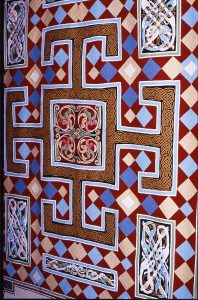
Lindisfarne Gospels tapestry
It was to Lindisfarne that Aidan came in 635, invited from Iona by Oswald to preach the good news across Northumbria. Why was this spot chosen as his spiritual headquarters? Perhaps its remote position offered some protection against the warring Saxon kingdoms, whose rivalries frequently ended in bloodshed. If safety was their main concern, they did not anticipate that, 150 years later, disaster would arrive from the sea in the form of Viking invaders. In 793, Lindisfarne was one of the first places to suffer the pillage and destruction which would eventually affect much of England. Whatever the reason, the position of Lindisfarne is deeply symbolic. It reflects the Christian dilemma of wanting to separate from the world and draw close to God, while also meeting the needs of a suffering world. Presumably, when the tide was in, Aidan and his monks could devote themselves to prayer and meditation and as it went out they could sally forth across the sands to preach and teach.
We can drive the mile or so across the causeway, past the platform helpfully provided for pedestrians cut off by the rising tide! Another two or three miles along the dunes brings us to the main part of the island about a mile square. Lindisfarne Castle itself is modern, designed by the architect Edwin Lutyens, with a garden nearby created by Gertrude Jekyll. It is worth a visit for the views it gives of Bamburgh and the Farne Islands.
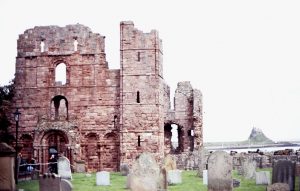
Lindisfarne Abbey
After Aidan's death, Cuthbert, who had begun life as a shepherd in the Scottish lowlands, came here as Prior of the monastery in about 663. In 676 he built himself a cell on Inner Farne, open to the sky, and remained there in solitude for nine years. He returned to Lindisfarne as Bishop in 685 and died two years later. Despite being neither a church reformer nor a great preacher, Cuthbert was held in extraordinary affection for his saintliness and simple lifestyle. In 875, monks fleeing the Danish invaders took his body with them. There followed years of wandering, like Moses and the Israelites, before Cuthbert's coffin finally came to rest in 998 in Durham, where it can still be seen in the Cathedral.
As well as laying the foundations of the Northumbrian church, the monks of Lindisfarne displayed artistic skills unrivalled in Europe at the time. The most famous product of their labour was the magnificent Lindisfarne Gospels, preserved in the British Library, which date from around 710. A marginal note identifies them as the work of a monk called Eadfrith. They miraculously survived the Viking invasions and later upheavals and remain one of Britain's finest artistic treasures. This barren, windswept coast seems an unlikely spot for the flowering of a unique culture, but so it was.
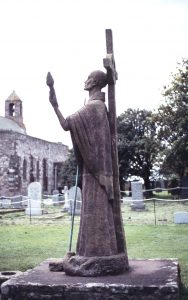
St Aidan statue
Lindisfarne today exploits the tourist potential of its heritage, but has not become tacky or over-commercialised. The Lindisfarne Heritage Centre has two rooms devoted to the Gospels, including a facsimile of the originals and an interactive version where you can turn the pages electronically. One wall is covered by a magnificent tapestry representing a page in the gospels and there are opportunities for children to try their hand at drawing Celtic patterns. Other rooms depict different aspects of island life including fishing, lifeboats and wildlife.
A short distance away, the Priory museum covers some of the same ground as the Heritage Centre, but gives more information on the lives of Aidan and Cuthbert and an artist's impression of what the monastery would have looked like in Saxon times. We can wander through the ruins of the twelfth century Priory, which fell into disrepair after the Reformation. In the grounds is the statue of a shaven-headed Aidan, with bishop's crook in one hand and torch in the other. A Celtic cross stands behind him and a seal has waddled up the beach to his feet.
The church of St Mary the Virgin has the names of the bishops who succeeded Aidan and Cuthbert and gives some of the later history of the monastery. On one side of the church is an arresting life-size wooden sculpture of six hooded monks carrying the body of Cuthbert with explanations of the designs that covered the lid of his coffin. There is yet another facsimile of the Lindisfarne Gospels, kindly provided by Rockford College, Illinois.
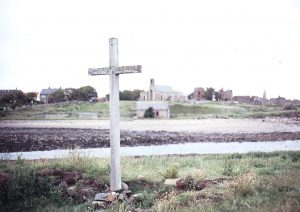
St Cuthbert's Isle
Behind the church a path leads down to St Cuthbert's Isle, an islet just offshore, about an acre in size and accessible at low tide. A cross marks the site of St Cuthbert's shrine, which stood here from 684 to 1537. Amongst other things, Cuthbert is celebrated as perhaps the world's first conservationist, declaring the eider duck a protected species. He seems to have been successful, because when we visited, an eider was swimming peacefully in a rockpool nearby.
FARNE ISLANDS
To reach the the Farnes, we take the boat from the little fishing port of Seahouses. These days the tourists are more plentiful than fish! Most come for the puffins, guillemots and seals, but some come for the history.
The outermost island of any size is Longstone, where Grace Darling's lighthouse still stands. We can stand in her bedroom and look out to the Harcar rocks, where on a stormy September day in 1838 she saw the Forfarshire aground and breaking up. The rest, as they say, is history and we can follow it up in the museum at Bamburgh.
Inner Farne is closest to the shore, about two miles off Bamburgh. It was from here, if Bede is to be believed, that Aidan saw the Mercians besieging the castle. As he prayed the winds veered round, sending the smoke and flames back on the besiegers. It was here too in 676 that the saintly Cuthbert built himself a cell with walls all round but open to the sky so as to concentrate his mind purely on eternal things. He remained alone for nine years (apart from occasional food drops, we must assume!). In 684 King Ecfrith arrived with his nobles imploring Cuthbert to accept the Bishopric of Lindisfarne. He eventually acceded to their pleas but resigned after two years and returned to Inner Farne, where he died three months later on March 20th 687.
There is a chapel dated 1530, with Aidan and Cuthbert in stained glass panels in the East window. There is also a memorial to Grace Darling, who lived on Inner Farne during her childhood. A stone-lined cistern on the island is known as St Cuthbert's Well.
KIRKNEWTON

Gefrin
In a remote valley close to the Scottish border, not far from Coldstream is the village of Yeavering. The name is the modern rendering of the Saxon Gefrin, where King Edwin had a palace (NE71 6HF). A semi-circular stone monument beside the road reminds us that Paulinus was here in 627, instructing the people in the Christian faith for thirty-six days continuously and baptising them in the River Glen, just beyond. We meet him again at Holystone not far to the south.
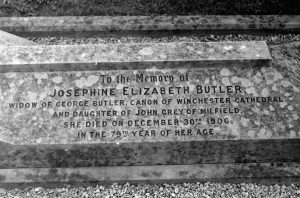
Grave of Josephine Butler
A little further up the valley is Kirknewton. The churchyard of St Gregory is the last resting place of Josephine Butler(1828-1906), wife of George Butler, a Canon of Winchester Cathedral. Born at Milfield Hill, just north of here, this formidable Victorian lady is remembered for her pioneering work for social reform. In particular, she campaigned against the humiliating treatment of prostitutes, an indelicate subject which most of her contemporaries preferred to avoid. She established refuges for them and extended her work across much of Europe.
HOLYSTONE
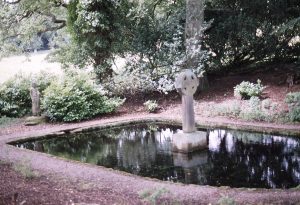
Holystone
We pass through wild, magnificent scenery to find yet another spot remembered for the labours of Paulinus in 627. He obviously had a busy year! The path behind the former Salmon Inn takes us through a field alongside a stream rich with wild flowers in summer. This leads to the Holy Well (or Lady's Well) maintained by the National Trust, which was once a watering place beside the old Roman road (NE65 7AJ). Here, shaded by trees, is a pool with a Celtic cross and a statue of Paulinus. The inscription tells us that he baptised 3,000 people here during Easter DCXXVII - Paulinus's personal Day of Pentecost. This was the same year and season as the baptism of King Edwin at York, so we must assume that many of his subjects were eager to follow the king's example as soon as possible and avoid any accusations of disloyalty.
FALLOWFIELD
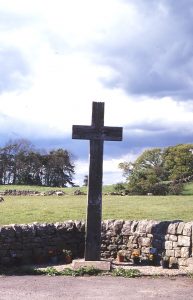
Site of the Battle of Heavenfield
In about 635, the Battle of Heavenfield was fought here just north of Hexham, close by Hadrian's Wall. King Oswald defeated the pagan King Cadwallon, who had killed King Edwin at Hatfield Chase a year or so before. It gave the embryonic Northumbrian church a much-needed breathing space. A wooden cross by the roadside on the B6318 marks the scene of this encounter and tells us that before the battle, Oswald prayed and ...obtained the victory as his faith deserved A.D. 635. Laus Deo. Just beyond, in a field of sheep, is the church of St Oswald, supposedly marking the exact site of the battle (NE46 4EY). A display in a room at the west end describes the action and the church also has a Roman altar dating back to about the year 200.
HEXHAM
Hexham Abbey (NE46 3NB) was founded by the energetic St Wilfrid (c 630-709) and the first church on the site was built between 672 and 678 on land donated by Queen Etheldreda. The only part remaining from that time is the Saxon crypt, of which the only comparable example - in Ripon cathedral in Yorkshire - is also associated with Wilfrid. Since the church was plundered by the Vikings and sacked five times by the Scots, it is remarkable that anything at all has survived. The later parts of the church are thirteenth century.
Wilfrid was fond of church appointments and at one time appears to have been simultaneously Abbot of Ripon, Bishop of York, Abbot of Hexham and in charge of Lindisfarne. However, his achievements are impressive and he visited Rome three times travelling mainly on foot. At one stage, in dispute with the king of Northumbria, he took refuge in Sussex and gained the hearts of the local people by teaching them how to fish with nets. A list of bishops tells us that Wilfrid held office from 686 to 692 and again from 705 to 709. The interval is probably explained by ecclesiastical disputes in which he was regularly engaged.
The Abbey displays pieces of stonework gathered from Hadrian's Wall and some stones with inscriptions are built into the walls. There is a Saxon font which may date back to Wilfrid's time and the base of an obelisk known as St Acca's cross. In the choir is a Saxon "frith stool", carved from a single piece of stone and known as St Wilfrid's chair.
HALTWHISTLE
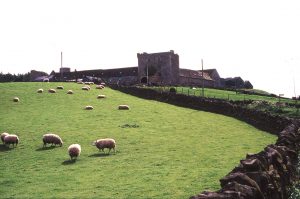
Willimontswick Farm
Where was the birthplace of Nicholas Ridley (1503-1555), Bishop of London and Protestant martyr of Queen Mary's reign? He came from a prominent family in the sparsely populated country between Hexham and Haltwhistle, but beyond that historians disagree. The most likely candidate is the remote, fortified farmhouse at Willimontswick near Haydon Bridge (NE47 7DB). Others point to Ridley Hall, not far away, or to Unthank Hall just south of Haltwhistle.
Willimontswick gets my vote. We reach the place, if we can find it, down a long single-track road beyond Beltingham, just south of the river Tyne. The buildings are arranged in a square with a ruined tower in one corner, formerly used a lookout for Scottish raiders stealing across Hadrian's Wall. St Cuthbert's church at Beltingham records that Ridley was baptised there although the present church building is later.
Ridley went to Pembroke College, Cambridge, in 1518 and gained rapid promotion through the ranks of church and university. He was a Fellow of Pembroke by 1524 and Master in 1540. In 1537, he was appointed chaplain to Archbishop Cranmer and in 1540 chaplain to Henry VIII himself. His adoption of Protestant views appears to have been gradual. The succession of Henry's young son as Edward VI gave full scope to his abilities. He became Bishop of Rochester in 1547 and Bishop of London in 1550. He was responsible for the foundation of three hospitals including St Thomas's and sixteen grammar schools throughout the country, many of which still carry the name of King Edward VI. The accession of the strongly Catholic Mary in 1553 brought an abrupt change in Ridley's fortunes. With his fellow bishop Hugh Latimer, he was tried and convicted for heresy. The heroic death of the two men, burned at the stake in Oxford, was one of the turning points of the English Reformation.
MORPETH

Robert Morrison's birthplace
On the north side of the town on Newgate Street is a small triangular area called Buller's Green (NE61 1DD). Over a brick arch on some terraced houses a notice tells us In Victoria's Jubilee year, this house replaced the one in which Robert Morrison D.D. was born. He surely deserves a more substantial memorial than this.
Morrison (1782-1834) was apprenticed to his father as a shoe last and boot-tree maker, but went to London to train as a missionary, at the same time studying Chinese. Appointed as a translator to the East India Company, he left for Canton in 1807, but spent much of the next twenty years preparing the first Chinese translation of the Bible, which was eventually published in twenty-one volumes in Malacca. He also compiled a three-volume Chinese dictionary and a grammar. Missionary efforts in China over the next century owed much to his work and he is held in high honour by Chinese Christians today.
NEWCASTLE-ON-TYNE
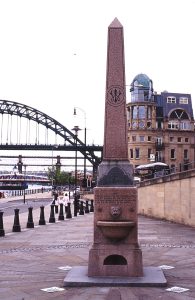
Wesley monument, Newcastle
The centre of Newcastle is all business, bustle and bridges, but down by the Tyne close to the new Millenium Bridge on Sandgate is a more peaceful spot now called Wesley Square (NE1 3LA). It was here on Sunday May 30th 1742 that John Wesley got up, sang a psalm to attract a crowd and preached his first sermon in the city. A granite obelisk marks the spot and quotes his text from Isaiah 53 He was wounded for our transgressions, he was bruised for our iniquities: the chastisement of our peace was upon him; and by his stripes are we healed.
Wesley described the response in his diary: Observing the people, when I had done, to stand gaping and staring upon me, with the most profound astonishment, I told them: If you desire to know who I am, my name is John Wesley. At five in the evening, with God's help, I design to preach here again. When he returned later in the day, he found the place filled with crowds larger than he had ever seen and he recorded that, After preaching, the poor people were ready to tread me under foot out of pure love and kindness.
It was the beginning of Methodism in Newcastle, and the following year a centre known as the Orphan House was opened. The name was inappropriate as it never served that purpose, but was used variously a Sunday School, bookshop and preaching centre. The site is marked by a plaque on 51 Northumberland Street and just round the corner is the Brunswick Methodist Church, dating from the early nineteenth century.


